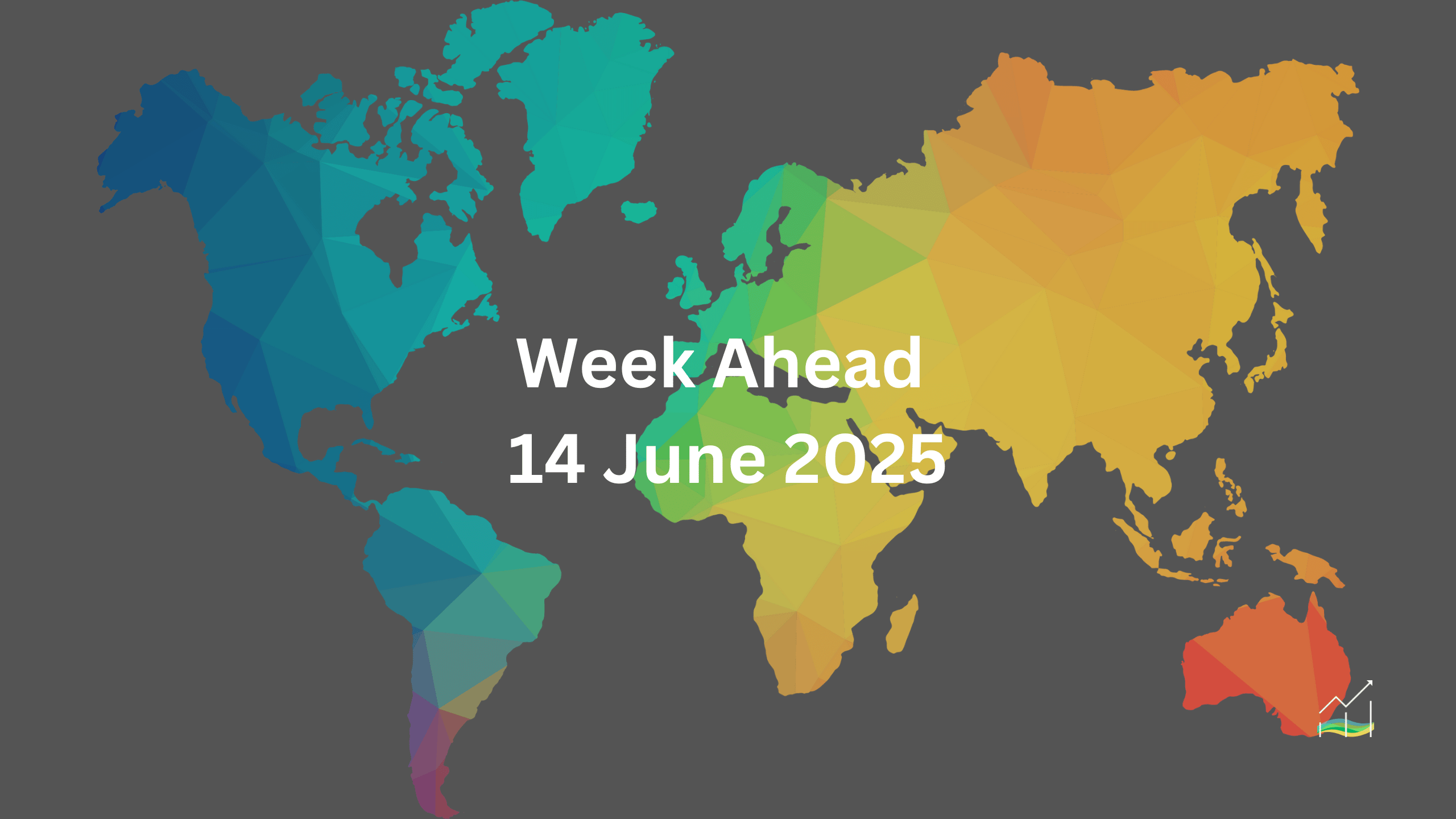14/06/2025 Week Ahead

Central Banks & Geopolitics in a Divided Global Market
Key Takeaways:
- Global markets showed little reaction to geopolitical risks, weakening the US dollar’s traditional role as a safe haven.
- Upcoming G7 meeting is unlikely to result in a unified or market-moving outcome.
- Trade tensions are resurfacing as the US prepares to escalate tariffs.
- Central banks including the Fed, BoJ, BoE, and SNB are set to meet this week, with no changes in policy expected from most.
- Market focus is on the Fed’s updated projections and possible QT guidance.
- SNB may cut rates, with the Swiss outlook still uncertain.
Markets gave a muted response to Israel’s strike on Iran, a reaction that aligns with the growing perception of the US dollar’s declining safe haven role. US stocks and Treasuries sold off ahead of the weekend, not dramatically but enough to reinforce concerns about the shifting balance in global capital flows. Rather than being a singular market-moving event, the geopolitical flare-up joins a broader list of risk factors quietly reshaping investor behaviour.
The G7 meeting in Canada may draw headlines, but the likelihood of a unified or decisive statement is low. Deepening rifts, especially the US’s increasing isolation, suggest that any formal declaration will be largely symbolic. Meanwhile, former President Trump’s renewed tariff rhetoric, including threats on autos and a promise to send tariff letters within weeks, is bringing trade tensions back into focus. These threats are likely to complicate negotiations with both Japan and the EU, further clouding the global trade landscape.
Monetary policy takes the spotlight this week. The Federal Reserve, Bank of Japan, and Bank of England are all expected to hold rates steady. The Fed’s updated economic projections and potential commentary on balance sheet reduction will be closely watched. Market pricing remains skeptical of the two additional hikes the Fed previously indicated. In Europe, the Swiss National Bank and Sweden’s Riksbank may cut rates, with the latter expected to reach a 2% floor. Although Swiss inflation remains low and speculation of a return to negative rates has surfaced, the SNB may avoid such a move given the absence of immediate exchange rate pressure.
Altogether, the week ahead blends geopolitics, trade risks, and central bank policy in a complex global environment that lacks a clear anchor. The lack of forceful market reactions and growing divergence in policymaking illustrate a world moving toward fragmented, multi-polar dynamics.
United States of America
Overview
The US dollar’s reaction to Israel’s strike on Iran was underwhelming, leading to questions about its reliability as a safe haven. This muted response feeds into a growing narrative that the dollar’s global role is gradually evolving. Despite rising interest rates, comparisons are being drawn between current capital flows and patterns typically associated with emerging markets, suggesting a shift in investor sentiment.
Attention this week will focus on the Federal Reserve’s meeting. While no rate changes are expected, the Summary of Economic Projections will guide market expectations. Historically, markets tend to realign with the Fed’s median projections rather than the reverse, making this release significant even amid prevailing uncertainty. Additionally, the Treasury’s monthly portfolio report covering April is likely to attract heightened interest, as it could offer insights into recent capital outflows and shifts in international investment behaviour.
On the economic front, headline retail sales are expected to remain soft due to a sharp drop in auto sales, although core retail components may show some resilience. Industrial production is likely to show a marginal increase after a flat performance in April, while housing starts are expected to be largely unchanged. These indicators collectively suggest a modestly weakening domestic demand environment, which may be masked by trade-driven GDP distortions in Q2. The resumption of student loan payments, a slowing labour market, and rising debt burdens are further contributing to consumer pressure.
Economic Drivers
- Dollar’s limited response to geopolitical tensions raises doubts about its safe haven status.
- Fed’s economic projections will shape market expectations, especially in the absence of policy changes.
- Trade-driven improvement in Q2 GDP may be masking weakening consumer fundamentals.
- Concerns about slowing job growth, resumed student loan repayments, and high debt stress.
- April’s Treasury portfolio data may reveal shifts in capital flows amid foreign selling or offshore diversification.
Data and Events
- 16 June 2025: Empire State Manufacturing Index.
- 17 June 2025: Retail Sales.
- 18 June 2025: Unemployment Claims.
- 19 June 2025: Federal Funds Rate.
- 19 June 2025: FOMC Economic Projections.
- 19 June 2025: FOMC Statement.
- 19 June 2025: FOMC Press Conference.
- 20 June 2025: Philly Fed Manufacturing Index.
Price Action
- Dollar Index (DXY) rebounded from a three-year low near 97.60 to around 98.60 after geopolitical escalation.
- Resistance is near 98.70. A break above this could target the 99.40–100.00 zone.
- The 20-day moving average sits at 99.20. DXY has not closed above it since May 19.
- A mid-May downtrend line also converges near the 99.20 level.
Key Points:
- The Fed is not expected to change rates but its projections will guide markets.
- Retail and industrial data may show weak consumer demand despite trade distortions in GDP.
- April’s TIC data will be closely watched amid talk of capital outflows.
- DXY technical levels indicate potential for recovery, but resistance remains firm.
- Dollar’s safe haven appeal appears to be weakening in the eyes of global investors.
Australia & New Zealand
Overview
The Australian dollar has exhibited shifting correlations in recent weeks, reflecting changing relationships with both global currencies and commodities. Over the past month, it has shown a stronger alignment with the US Dollar Index than the Canadian dollar, but on a 60-day basis, the reverse is true. Meanwhile, its consistent correlation with gold remains notable, indicating sensitivity to broader risk sentiment and commodity trends.
Australia’s labour market has remained stable through April, adding over 100,000 jobs in the first four months of 2025. However, this is a slowdown compared to the same period last year. Most of the new employment was in full-time positions, though the ratio of full-time to total jobs created has declined slightly. Unemployment is steady at 4.1%, while the participation rate has edged higher. The market is currently pricing in a high probability of a rate cut at the Reserve Bank of Australia's next meeting in early July, as the central bank remains focused on maintaining stability amid softening global conditions.
Economic Drivers
- Short-term movements in the Australian dollar are more correlated with the Dollar Index, while longer-term movements align more closely with the Canadian dollar.
- A consistent medium-term correlation with gold reflects the currency’s link to commodity performance and global risk appetite.
- Labour market stability continues, but job growth is slowing year-on-year.
- The unemployment rate remains unchanged, while workforce participation is increasing.
- Futures pricing indicates about an 80% chance of a rate cut at the July 8 RBA meeting.
Data and Events
- 19 June 2025: New Zealand's GDP.
- 19 June 2025: Employment Change.
- 19 June 2025: Unemployment Rate.
Price Action
- AUD fell to a seven-day low near $0.6455 following initial risk-off sentiment from Middle East tensions.
- Recovered to $0.6515 before stalling, ending the week mostly flat.
- AUD reached a seven-month high last week just below the $0.6550 retracement level.
- On a year-to-date basis, AUD remains the weakest G10 currency, up by less than 4.9%.
Key Points:
- Australian labour market remains steady but is slowing compared to last year.
- AUD correlations vary between short- and long-term periods, especially with the DXY and CAD.
- Market is anticipating a possible RBA rate cut at the upcoming meeting.
- Despite a recovery late last week, AUD remains the weakest G10 performer so far this year.
Canada
Overview
The Canadian dollar has been increasingly influenced by broader US dollar trends, with its short- and medium-term movements showing some of the strongest correlations seen this year. Correlation with the Dollar Index has overtaken more traditional drivers like crude oil and domestic interest rates. Interestingly, changes in gold prices now appear more aligned with the Canadian dollar’s performance than oil or equities, underscoring the evolving nature of its sensitivities in global markets.
Economic data this week includes April’s retail sales and portfolio flow figures. In March, retail sales rose modestly, largely due to strong auto sales. However, core retail components declined, pointing to underlying weakness. Preliminary estimates for April suggest a partial rebound. Despite these fluctuations, market expectations for monetary policy remain subdued. The probability of a July rate cut by the Bank of Canada is currently less than one-third, and only one full cut is priced in for the second half of the year. Meanwhile, foreign investors were net sellers of Canadian assets in Q1 2025, a stark reversal from the buying seen during the same period last year.
Economic Drivers
- Canadian dollar is increasingly driven by movements in the US Dollar Index, with high short- and medium-term correlations.
- Gold has become a stronger influence than oil, short-term rates, or equity markets on Canadian dollar performance.
- March retail sales rose due to autos, but core components declined, indicating weak underlying demand.
- Preliminary data suggests a 0.5% rise in April retail sales.
- Foreign investors sold C$10 billion in Canadian assets during Q1 2025, reversing from net buying in Q1 2024.
- Market sees limited scope for near-term Bank of Canada rate cuts, with only one cut priced in for H2 2025.
Data and Events
- 18 June 2025: BOC Gov Macklem Speaks.
- 20 June 2025: Retail Sales.
Price Action
- Canadian dollar and Norwegian krone were the only G10 currencies to appreciate against the US dollar heading into the weekend.
- USD/CAD reached a fresh eight-month low near 1.3565 before rebounding to just under 1.3600.
- Despite oil’s rally, the correlation between CAD and oil is minimal or even inverse in the short term.
- Technical support is seen in the 1.3475 to 1.3500 zone, though downside momentum may become stretched before reaching it.
Key Points:
- CAD performance is now more tied to gold and the broader USD trend than oil.
- Retail sales data suggest modest recovery, but core weakness persists.
- Foreign portfolio flows have turned negative, highlighting capital flight risks.
- Market expectations for BoC policy remain dovish but cautious, with only one cut fully priced for H2.
- USD/CAD has approached technical support, but further downside may be limited near-term.
China
The Chinese yuan has been one of the most stable major currencies against the US dollar this year, appreciating by roughly 1.75%. This stability is not incidental but the result of deliberate policy efforts by Beijing, which continues to maintain a managed exchange rate regime. Such stability echoes earlier periods of fixed-rate systems in global economic history, though China’s approach is more flexible and strategically timed. As the dollar weakens more broadly, the yuan may also soften on crosses, increasing its appeal as a funding currency in carry trades.
China’s economic momentum remains fragile. Early indicators suggest May's real sector performance was weak, with PMIs pointing to a subdued backdrop for industrial production and retail sales. Activity at US west coast ports reportedly slowed to a crawl by the end of May, despite signs that some shipments had been rushed through before new tariffs took effect. Domestic consumption and housing remain under pressure, with no indication that prices have bottomed. Despite this softness, Chinese authorities appear hesitant to introduce further fiscal or monetary stimulus. The People’s Bank of China is expected to leave the loan prime rates unchanged, reflecting a cautious policy stance.
Economic Drivers
- The yuan’s stability against the US dollar is policy-driven and strategically managed by Beijing.
- Historical context suggests China values exchange rate stability to support economic growth.
- Weak real sector data is anticipated, with industrial output and retail activity likely slowing in May.
- House prices remain under pressure, with no visible bottom.
- Officials are reluctant to deploy additional fiscal or monetary easing.
- Loan prime rates are expected to remain steady at 3.0% (1-year) and 3.5% (5-year).
Data and Events
- 16 June 2025: Industrial Production.
- 16 June 2025: Retail Sales.
- 20 June 2025: 1-y & 5-y Loan Prime Rate.
Price Action
- USD/CNH fell below 7.17 on 12 June, marking the weekly low, before rebounding toward 7.19 ahead of the weekend.
- Weekly high was near 7.20. A firm break above could open the path to the 7.2240–7.2260 range.
- The PBOC set the dollar reference rate at 7.1772, the lowest in two months, and lowered the fix four sessions in a row.
- This pattern suggests some tolerance for yuan appreciation, although official limits likely remain.
Key Points:
- Yuan remains one of the most stable G10 currencies this year, guided by policy intervention.
- May data is expected to confirm weak economic conditions across retail, industry, and housing.
- Authorities appear cautious, holding back on stimulus despite deteriorating activity.
- PBOC fix signals controlled appreciation, limiting upside for USD/CNH in the near term.
Europe
Overview
The euro has faced a temporary setback after rallying above $1.1630 earlier in the week, as geopolitical tensions interrupted its upward momentum. While the correction halted a four-day streak, support levels remained intact by the end of the week. Broader influences on the euro's performance are shifting, particularly in relation to interest rate differentials. The correlation between EUR/USD and the US-German 2-year yield spread has significantly weakened from its highs late last year, indicating changing market dynamics. The spread's impact on currency movements has diminished as the European Central Bank moves further ahead in its easing cycle compared to the Federal Reserve.
Expectations remain that the ECB will pause rate cuts before delivering one final reduction later this year. This stance, combined with still-light investor positioning in eurozone assets, is likely to support moderate currency resilience in the near term. However, incoming data will need to offer more than just headlines to meaningfully influence market expectations. This week’s releases, including the current account balance, construction output, and Germany’s ZEW survey, are unlikely to shift the broader outlook unless they diverge significantly from expectations.
Economic Drivers
- The ECB is leading the Fed in the current easing cycle, creating a fundamental divergence in monetary policy paths.
- The correlation between EUR/USD and the US-German 2-year yield spread has fallen significantly, reducing the influence of interest rate differentials.
- Eurozone investment allocations remain underweight compared to the US, offering potential for rebalancing flows.
- Market expectations point to a brief pause in ECB cuts, with one more reduction anticipated before year-end.
Data and Events
- 17 June 2025: German ZEW Economic Sentiment.
- 18 June 2025: Current Account.
- 18 June 2025: Final CPI.
- 18 June 2025: German 30-y Bond Auction.
- 19 June 2025: Eurogroup Meetings.
- 20 June 2025: German PPI.
- 20 June 2025: Consumer Confidence.
Price Action
- EUR/USD peaked above 1.1630 on 12 June before retreating following geopolitical tensions.
- The pair held above support at 1.1485, keeping the June rally technically intact.
- Key downside level rests near 1.1370, with the 20-day moving average just above at 1.1385.
- Euro has not settled below its 20-day moving average in nearly a month, suggesting resilient short-term support.
Key Points:
- Euro’s rally paused but remains intact above key technical levels.
- ECB’s policy divergence from the Fed is now largely priced in, with reduced yield spread impact on the euro.
- Investors remain cautious but underweight eurozone assets, providing potential for inflows.
- This week’s economic data is unlikely to materially shift expectations unless sharply surprising.
Japan
Overview
The Bank of Japan continues to navigate the difficult task of normalising monetary policy in a weak economic environment. Japan’s economy contracted by 0.7% quarter-over-quarter in Q1, even as inflation remains elevated. The BOJ has slowed its government bond purchases, which is adding pressure to the long end of the yield curve. Meanwhile, the yen remains highly sensitive to the broader US dollar trend, with a rolling 60-day correlation to the Dollar Index nearing 0.90 — the highest in three decades. In contrast, its correlation with US 10-year yields has dropped significantly from early 2025 levels.
Markets are focused on the upcoming BOJ meeting where Governor Ueda is expected to reaffirm the central bank’s guidance for future tightening, contingent on economic developments. However, market pricing suggests a very low probability of rate hikes in the near term, with less than 10 basis points priced in until October and no full quarter-point hike expected by year-end. This reflects a notable shift from Q1 expectations, which had priced in 75 basis points of tightening. Inflation data is also due, with national CPI figures for May expected to reaffirm persistent underlying price pressures, building on Tokyo’s earlier report showing rising core inflation.
Economic Drivers
- Japan’s economy contracted by 0.7% in Q1, limiting the BOJ’s flexibility in normalising policy.
- Inflation remains high, with core national CPI rising and Tokyo data pointing to continued upward pressure.
- BOJ has reduced its government bond purchases, affecting the long end of the yield curve.
- Yen movements remain highly correlated with the US Dollar Index, indicating external influence on exchange rate behaviour.
- The yen’s correlation with US 10-year yields has weakened substantially since Q1.
Data and Events
- 17 June 2025: BOJ Policy Rate.
- 17 June 2025: Monetary Policy Statement.
- 17 June 2025: BOJ Press Conference.
- 18 June 2025: Core Machinery Orders.
- 18 June 2025: Trade Balance.
- 20 June 2025: National Core CPI.
- 20 June 2025: Monetary Policy Meeting Minutes.
- 20 June 2025: BOJ Gov Ueda Speaks.
Price Action
- Yen briefly strengthened following geopolitical headlines, reaching weekly highs near JPY142.80.
- Broader US dollar strength and rising US yields reversed the move, pushing USD/JPY back to nearly JPY144.50.
- The recent high remains at JPY145.45, set mid-June.
- Short-term direction is closely tied to US dollar performance and interest rate dynamics.
Key Points:
- BOJ is unlikely to move rates near-term despite persistent inflation.
- Market expectations for tightening have been revised sharply lower since Q1.
- Inflation momentum remains a concern, with both national and Tokyo data showing rising core prices.
- Yen remains heavily influenced by dollar trends rather than domestic fundamentals.
United Kingdom
Overview
Sterling reached a new three-year high last week, though not due to strong domestic fundamentals. Instead, the move was largely driven by broad-based US dollar weakness. The pound’s strength comes despite a string of disappointing UK economic data. Correlation analysis highlights how closely sterling is now tracking the Dollar Index, with a 30-day correlation nearing 0.90 and the 60-day measure holding around 0.80 for over a month. These high correlations reflect external rather than internal forces driving the exchange rate.
Forward guidance from Bank of England officials has encouraged markets to expect a slow approach to policy easing. However, recent economic data may force a reassessment. Market pricing for rate cuts initially increased after April but has since dropped sharply as data failed to support continued hawkishness. The upcoming week is packed with data, including May CPI, the Bank of England policy meeting, and retail sales. While no change in policy is expected from the BOE, CPI figures and retail performance could influence future rate expectations.
Economic Drivers
- Sterling’s recent rally was driven by a weaker US dollar rather than improved UK data.
- Rolling correlations with the Dollar Index are exceptionally high, showing external influence on the pound.
- Bank of England guidance suggests a gradual easing path, though disappointing data is weakening that narrative.
- Swaps market pricing for BOE cuts has dropped significantly, with a full cut not priced until November.
- Gilt yields have risen modestly, reflecting rate uncertainty.
Data and Events
- 18 June 2025: CPI.
- 19 June 2025: Monetary Policy Summary.
- 19 June 2025: MPC Official Bank Rate Votes.
- 19 June 2025: Official Bank Rate.
- 20 June 2025:
Price Action
- GBP/USD touched a three-year high just above 1.3630 before retreating following geopolitical tensions.
- The pair fell to nearly 1.3515, breaching the previous day’s low but closing back within range.
- Key technical support is located between 1.3455 and 1.3465.
- Despite pullback, price action neutralised potential bearish signals for now.
Key Points:
- Sterling strength is externally driven, not supported by UK fundamentals.
- BOE is expected to hold steady, but market expectations for cuts are being reassessed.
- CPI and retail data this week could shift short-term sentiment.
- Technical support remains intact, limiting downside for now.
© 2025 SKONE Enterprise (003319453-V). All rights reserved.
The content on this site is for informational purposes only and does not constitute financial advice.


